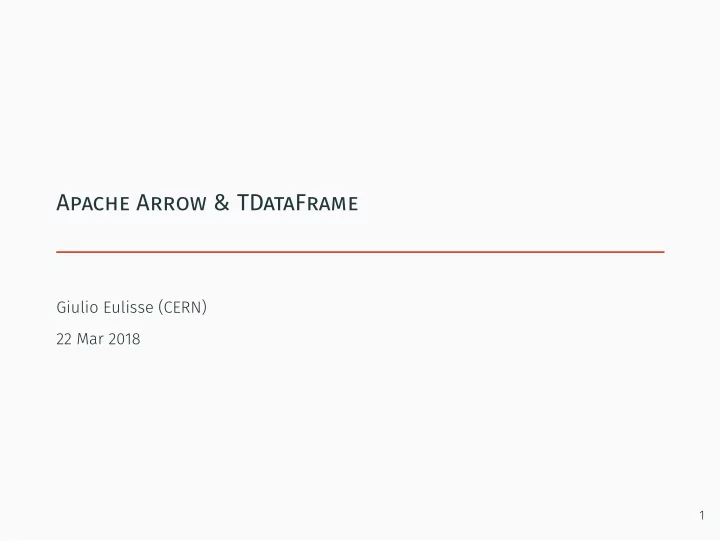

Apache Arrow & TDataFrame Giulio Eulisse (CERN) 22 Mar 2018 1
Apache Arrow: the project “Apache Arrow is a cross-language development platform for in-memory data” Well established. Top-Level Apache project backed by key developers of a number of opensource projects: Calcite, Cassandra, Drill , Hadoop, HBase, Ibis, Impala, Kudu, Pandas, Parquet, Phoenix, Spark, and Storm. Very active. 119 contributors, https://github.com/apache/arrow Why is ALICE looking into it? • Zero-Copy buffer adoption (well suited for our shared memory backed message passing). • Interoperability with other tools (e.g. Pandas, Spark, Tensorflow, .. ) • ROOT interoperability is of course keystone. 2
Apache Arrow: technical details In memory column oriented storage. Full description https://arrow.apache.org/docs/memory_layout.html. Data is organized in Nullable fields. An extra bitmap can optionally be provided to tell if a given slot in a column is occupied. usual record shredding presented in Google’s Dremel paper) to support No polymorphism. The type in an array can be nested, but there is no polymorphisms available (can be faked via nullable fields). 3 Table s. Tables are made of Column s. Column s are (<metadata>, Array) . An Array is backed by one or multiple Buffer s. Nested types. Usual basic types ( int , float , ..). It’s also possible (via the nested types. E.g. a String is a List<Char> .
Integrating Arrow and TDataFrame: TArrowDS TArrowDS. Arrow is a perfect match as TDataFrame backend, so I wrote Initial development. Quickly done thanks to the hints from Danilo and Enrico. https://github.com/root-project/root/pull/1712. Roughly 3 full days of development. idea and I will probably write one at some point. 4 TArrowDS mimicking TCsvDS . Would be nice extensions. A lazy version of TArrowDS is probably a good
Overall, easy to use API. My comments are really on how to improve things further, not compliants. I am already really pleased with the current API. Bulk API. Current API is entry by entry, however very often you can guarantee at least partial contiguous entries so it would be nice to have a bulk API. Non rectangular sources. Right now all the columns need to have the same set of entries and it’s a construction time imposition. IMHO, it would be nice to to have such a check imposed when performing an action on given columns, not at data source construction time. 5 TDataSource : Feedback auto [ptr, minEntry, maxEntry, size, stride] = \ SetEntryBulk(slot, attemptedMin, attamptedMax);
TDataSink. For my usecase, I need to pass results downstream to a different Support for dynamic partitioning. Given a collection of N objects (say, tracks), spanning M events, I want to be able to say: • Group tracks by event. • Apply reduction function on each group of tracks. • Store results in a separate column. Support for emitting more than one result. Given a collection of N objects I want to be able to emit more than one result which will end up as consecutive entries in a separate column. 6 TDataFrame : Feedback device via a memory mapped region. I can of course have a Foreach() to copy them back to a arrow::Array . It would be nice to be able to write directly to an arrow::Array or at least to get pointer I can adopt in a arrow::Buffer .
Support for combinations. Given a collection of N objects of type T and M Support for joins. Given a collections of associations between elements of a column N and elements of a column M, for each one of the associations 7 TDataFrame : Feedback objects of type V I want to be invoked for all the NxM combinations and emit f(n,m) calculate f(n,m) .
Recommend
More recommend